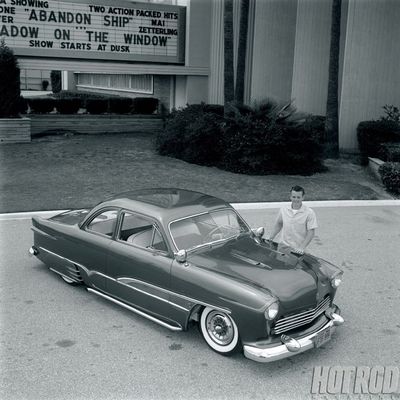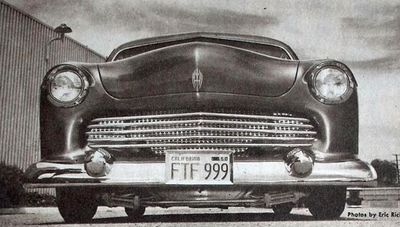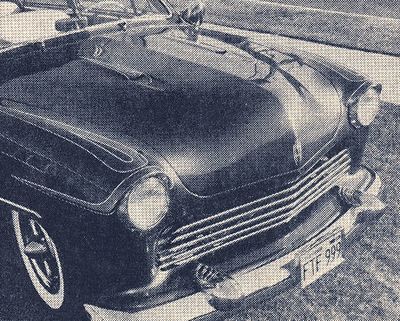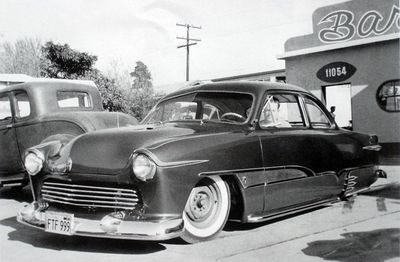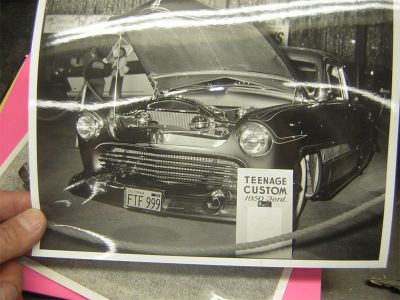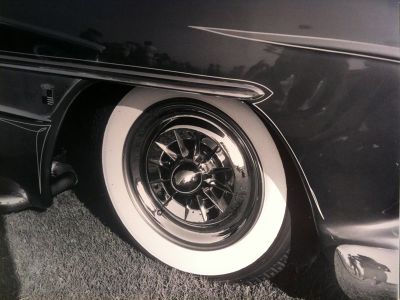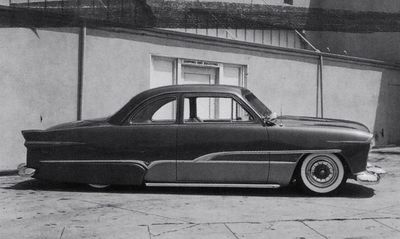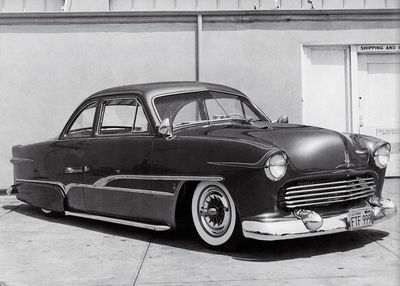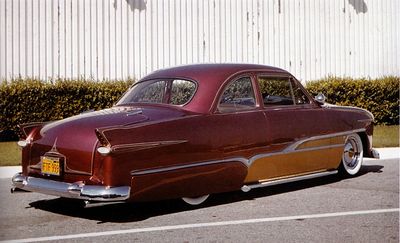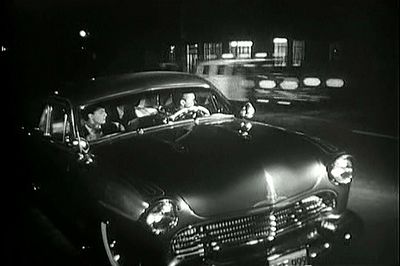Junior Conway's 1950 Ford



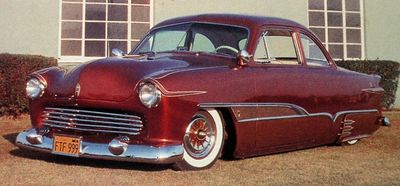
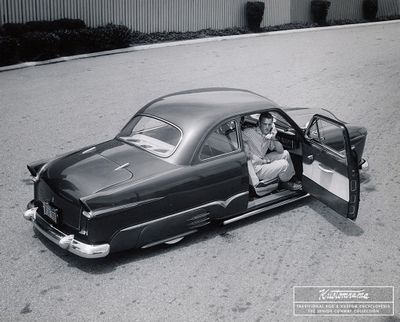



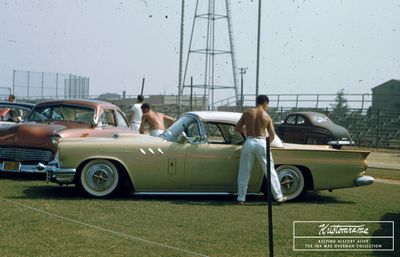
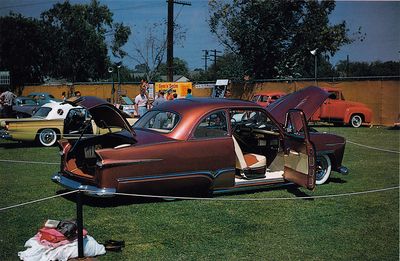
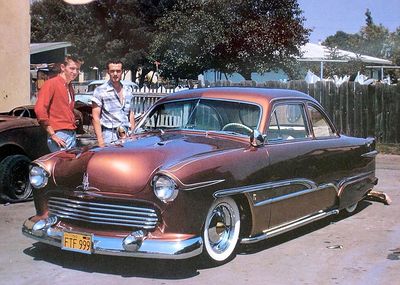

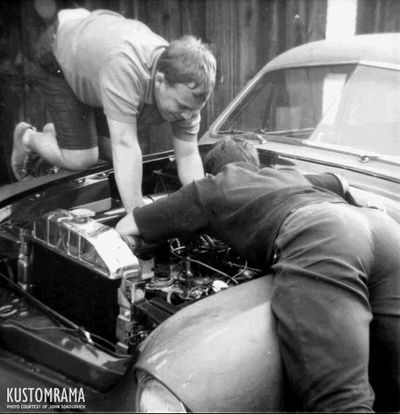
1950 Ford originally owned by Herb Conway of Compton, California. Herb bought the car in January of 1953,[1] after he and his little brother Junior had restyled Herb's first car, a 1941 Ford Coupe. Herb and Junior used to cruise around used car lots looking for possible trades. One day they came across the Ford, and a deal was made. The Ford had already been mildly restyled and repainted gold. It had primer on the reworked areas, which included a shaved 1951 Ford hood, a straight grille bar, and a new molded front gravel shield. Kinch's Body Shop was responsible for the work. The car had also been lowered, and it ran a Gaylord headliner. Back home, Herb, Junio, and their dad welded up the deck lid, installed dual Appleton spotlights, and shaved the door handles. All of this was done with a blow torch. During Herb's ownership Junior paid for the interior to be finished. Russ & Bess in Compton did the work.
Contents
Sold to Junior
Junior bought the car from Herb while he was attending high school. After school he worked at Barris Kustoms, and got guidance and assistance during the build from the guys at the shop. It was his buddy Dick "Peep" Jackson that got Junior a job at Barris Kustoms. In addition to the treatments above, Junior's first version of the car did also feature frenched 1951 Ford taillights. [2]
The Teardrop Version
After being involved in an accident, Junior restyled the car into the famous Teardrop version. The Teardrop version was a lot more radical then the first version. The second version of the car was modified with later model type finned fenders that ran 1955 Buick taillights. Fake back up lights were made from white lexan with beveled clear lenses. Junior fit the car with an unique side-trim made from two sets of 1955 Ford Fairlane 2 door side trim pieces that was dressed upt with gold perforated mesh. The upper spears of the side trim was from a 1954 Dodge. The car did also receive 1950 Mercury fender skirts that ran three 24-karat gold plated teeth forming functional airscoops. The teeth were 1/4 inch round rods frenched into the rear panels. Bill Carr rounded the door courners. Doors, deck and hood were shaved and operated by electrical pushbuttons. 1949-1950 Ford glove box door locks were integrated into the side trim in order to open the shaved doors. Up front the car featured headlight shades built from California Custom Accessories items available for any car. The headlight shades were fit 1955 Chevrolet headlight rims that were drilled and used as airscoops for the front wheels and brakes. George Barris helped Junior with the build, and he cut twin air scoops half-way back on the hood of the car. The hood corners were rounded and fit to the curves in the 1949 Mercury grille shell. Horizontally positioned 3/4 inch round steel bars were used to fabricate a grille for the car. Junior originally planned to run a 1954 Pontiac grille bar, but decided to make his own floating grille instead, for a new and modern look. Bill Carr and George Barris helped out with the engineering and the installation of the grille. A perforated mesh grille was placed behind the outer grille. The bumpers were reshaped 1951 Chevrolet units, cut to fit 1953 Mercury bumper bullets. Junior welded the bullets to the bumpers. The chrome would not stay where the welds were, so he had to rechrome the bumper three times while he owned the car. The front gravel shield on the car was molded to the body when Herb first bought it, and the rear gravel was originally intended to be molded to the body too, but due to the crush to get the car ready for a show in late 1956, Junior decided to skip this modification.[2]
Upholstered by Jack's Top Shop
The interior was upholstered by Jack's Top Shop, who also did a matching upholstery for the trunk. The interior of the car featured a radio-telephone. If you look on color interior shots of the car you will see a chromed heater placed at the passenger side of the car. This heater was in one story about the car described as being a TV set, a fact that is not true. The steering wheel was a 1955 Mercury accessory steering wheel.[2]
Scallops by Dean Jeffries
The car was lowered up front by installing dropped spindles and cutting the coils. The frame was also modified where the A arms attached. In the rear the springs were de-arched, and 4" blocks were installed. The body was painted by George Barris in a two tone Rustic metallic lacquer with scallops applied by Dean Jeffries. This version of the car did also have a little pinstriping by Dean. More pinstriping and functional chromed lake pipes were added later. This version of the car rolled on a set of candy painted custom hubcaps. After a while, Junior also installed new fender skirts from a 1957 Mercury Turnpike Cruiser on the car, and painted it gold on the sides under the lower side-moldings. After showing the car like this for a while, the custom hubcaps were replaced with chromed and reversed wheels. Junior did also install rippled non-functional lake pipes. This version is the last version of the car while Junior owned it. In 2010 while Jerry Daman was working on re-creating the car he asked Junior what his favorite version was, and he told him that it was "the last one".[2]
Movie Appearance
In 1959, Junior's Shoebox appeared in the movie the T-Bird Gang.
1950 Not 1949
Due to wrong information in old magazines the car was for many years referred to as a 1949 Ford. Through research done by Jerry Daman while he cloned the car, Junior told Jerry that the car was actually a 1950 Ford and not a 1949 Ford.
Sold to the East Coast
In the early 1960s the car was located in Natrona Heights, Pennsylvania. It had been purchased by a local guy doing some military time in California. It made its way to Alaska, then to Tarentum, Pennsylvania, where Larry Ellenberger bought it. Larry was 17 years old at the time, and a senior in high school. When Larry got the car It had been painted white. All the chrome intact, and the original flathead was still under the hood. It was driveable, but had a crack in the block and leaked pretty good, so Larry swapped the stock engine for a newer Pontiac engine. By then the dash had been chromed with parts of it being painted and pinstriped.
Sold to John Sokolovich
In 1963 Larry sold the car to his friend John Sokolovich of New Oxford, Pennsylvania. According to a letter by John that was published in Rod & Custom December 1988 Larry pulled the flathead out to warm up a 1940 Ford sedan he was also working on, and proceeded to put a Pontiac V-8 in the car. The winter weather cracked the engine block, and brought him to the reality that trying to build two machines at the same time was a bit much, so he sold the car to John for a decent price. John replaced the cracked engine with a 389 Pontiac, and he began to redo the body. The fins were the first modification he undertook, fins were the brunt of joking in the 1960s, so he replaced them with standard Ford fender tops and reworked the taillights into triangular shapes fitted with flat plexiglass. While working on the car John verified that the car was Junior Conway's old custom. A couple of more months of work went into the car, and he started to run into some really discouraging situations. The Pontiac exhaust headers wouldn't clear the steering box. To change the rear spark plug would require pulling the engine. "I had the car running up and down the alley with no exhaust on," John told Kustomrama. He did also have problems with the V-butted windshield as it would not pass the Pennsylvania state vehicle inspection because they declared it cracked from the top to the bottom.[3] Parental pressure, and the need for garage space pushed John into selling the car around 1963 - 1964.[4]
Danny Weaver
The guy John sold the car to never got it on the street, and it was placed in a field for years. The days in the field were bad for the car, and it ended up at a small junkyard in Dime, Pennsylvania called Benny's.[2] In 2017 John told Kustomrama that he sold the car to Danny Weaver, who worked at the local Atlantic station; "I was in college and really lost contact with him and the car. Several years later I found it at Benny’s junkyard. It was sunken into the mud to above the rocker panels and it looked like someone danced on the hood and roof. Back then there really wasn’t a lot of interest in custom cars. The mid 1960s brought in the muscle cars."[4]
Clones
Magazine Features
Custom Cars September 1957
Custom Cars November 1957
Motor Life January 1958
Car Craft March 1958
Custom Cars March 1958
Rod & Custom September 1960
Trend Book 143 Restyle Your Car
References
Sources
Trend Book 143 Restyle Your Car
Motor Life January 1958
Custom Cars November 1957
Rik Hoving Custom Car Photo Archive
Did you enjoy this article?
Kustomrama is an encyclopedia dedicated to preserve, share and protect traditional hot rod and custom car history from all over the world.
- Help us keep history alive. For as little as 2.99 USD a month you can become a monthly supporter. Click here to learn more.
- Subscribe to our free newsletter and receive regular updates and stories from Kustomrama.
- Do you know someone who would enjoy this article? Click here to forward it.
Can you help us make this article better?
Please get in touch with us at mail@kustomrama.com if you have additional information or photos to share about Junior Conway's 1950 Ford.
This article was made possible by:
SunTec Auto Glass - Auto Glass Services on Vintage and Classic Cars
Finding a replacement windshield, back or side glass can be a difficult task when restoring your vintage or custom classic car. It doesn't have to be though now with auto glass specialist companies like www.suntecautoglass.com. They can source OEM or OEM-equivalent glass for older makes/models; which will ensure a proper fit every time. Check them out for more details!
Do you want to see your company here? Click here for more info about how you can advertise your business on Kustomrama.

